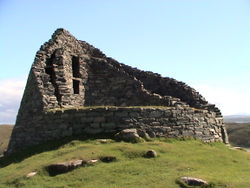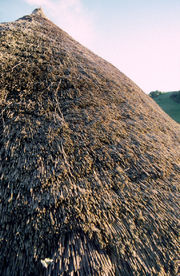Iron Age
2007 Schools Wikipedia Selection. Related subjects: Ancient History, Classical History and Mythology
In archaeology, the Iron Age is the stage in the development of any people where the use of iron implements as tools and weapons is prominent. The adoption of this material coincided with other changes in some past societies often including differing agricultural practices, religious beliefs and artistic styles, although this was not always the case.
The Iron Age is the last principal period in the three-age system for classifying pre-historic societies, preceded by the Bronze Age. Its date and context varies depending on the country or geographical region. Classically, the Iron Age is taken to begin in the 12th century BC in the ancient Near East, ancient Greece (with the Greek Dark Ages), and ancient India (with the post- Rigvedic Vedic civilization). In other regions of Europe, the Iron Age began in the 8th century BC in Central Europe and the 6th century BC in Northern Europe. The Iron Age is usually taken to end in the Mediterranean with the onset of historical tradition during Hellenism and the Roman Empire, the onset of Buddhism and Jainism in India, the onset of Confucianism in China, or the early Middle Ages in the case of Northern Europe.
The Iron Age roughly corresponds to the stage at which iron production was the most sophisticated form of metalworking. Iron's hardness, high melting point and the abundance of iron ore sources made iron more desirable and "cheaper" than bronze and contributed greatly to its adoption as the most commonly used metal. The arrival of iron use in various areas is listed below, broadly in chronological order. Because iron working was introduced directly to the Americas and Australasia by European colonization, there was never an iron age in either location.
The Iron Age
By the Middle Bronze Age, increasing numbers of smelted iron objects (distinguishable from meteoric iron by the lack of nickel in the product) appear throughout the Levant, the Mediterranean, in Anatolia, Egypt, Mesopotamia and the Indian subcontinent. In some places, their use appears to be ceremonial, and iron was an expensive metal, more expensive than gold. Some sources suggest that iron was being created in some places then as a by-product of copper refining, as sponge iron, and was not reproducible by the metallurgy of the time.
But, in Anatolia, iron is systematically produced from a large source of meteoritic iron, not far from Bronze Age sources of other metals. The earliest systematic production and use of iron implements ther. By 1200 BC, iron was widely used in the Middle East but did not supplant the dominant use of bronze for some time. At around 1800 BC, for reasons as yet unascertained by archaeologists, tin became scarce in the Levant, leading to a crisis of bronze production. Copper itself seemed to be in short supply. Various "pirate" groups around the Mediterranean, from around 1700-1800 BC onward began to attack fortified cities in search of bronze, to remelt into weaponry. Anatolia had long been a source of bronze, and its use of iron (from 2000 BC onward) had developed, by at least 1500BC into the manufacture of weaponry superior to bronze. Sub-Saharan production of iron began at around the same time, and seems to be clearly an independent invention (see Stanley J. Alpern's work in History in Africa, volume 2). Places that contained iron developed a prominence in the last millenium BC that would last into the future. The emanation of iron, combined with a military technology designed to complement the use of metals, emanated from Assyria. It is likely an Assyrian-manufactured macehead that was found in 1902 at Troy at a level dated to around 1200 BC. Assyria in fact may have considered Troy an outpost or suburb of itself. At any rate, iron trade between the two places was well established by that time, with the Assyrians jealously guarding their trade secrets of production.
Ancient Near East
The Iron Age in the Ancient Near East is believed to have begun with the discovery of iron smelting and smithing techniques in Anatolia or the Caucasus in the late 2nd millennium BC (circa 1300 BC). From here it spread rapidly throughout the Near East as iron weapons replaced bronze weapons by the early 1st millennium BC. The use of iron weapons by the Hittites is believed to have been a major factor in the rapid rise of the Hittite Empire. Because the area in which iron technology first developed was near the Aegean, the technology propagated equally early into both Asia and Europe, aided by Hittite expansion. The Sea Peoples and the related Philistines are often associated with the introduction of iron technology into Asia, as are the Dorians with respect to Greece. It ought also be noted that the Assyrian Empire had trade contacts with the area in which iron technology was first developed at the time that it was developing.
Europe
Iron working was introduced to Europe around 1000 BC, probably from Asia Minor and slowly spread northwards and westwards over the succeeding 500 years.
Eastern Europe
The early 1st millennium BC marks the Iron Age in Eastern Europe. In the Pontic steppe and the Caucasus region, the Iron Age begins with the Koban and the Chernogorovka and Novocerkassk cultures from ca. 900 BC. By 800 BC, it was spreading to Hallstatt C via the alleged " Thraco-Cimmerian" migrations. From the Hallstatt culture, the Iron Age spreads west with the Celtic expansion from the 6th century BC. In Poland, the Iron Age reaches the late Lusatian culture in about the 6th century, followed in some areas by the Pomeranian culture.
The ethnic ascriptions of many Iron age cultures has been bitterly contested, as the roots of Germanii and Slavs were sought in this area.
Central Europe
In Central Europe, the Iron Age is generally divided in the early Iron Age Hallstatt culture (HaC and D, 800- 450) and the late Iron Age La Tène culture (beginning in 450 BC). The Iron age ends with the Roman Conquest.
Italy
In Italy, the Iron Age was probably introduced by the Villanovan culture but this culture is otherwise considered a Bronze Age culture, while the following Etruscan civilization is regarded as part of Iron Age proper. The Etruscan Iron Age was then ended with the rise and conquest of the Roman Republic, which conquered the last Etruscan city of Velzna in 265 BC.
British Isles
In the British Isles, the Iron Age lasted from about the 5th century BC until the Roman conquest and until the 5th century A.D. in non-Romanised parts. Defensive structures dating from this time are often impressive, for example the brochs of northern Scotland and the hill forts that dotted the rest of the islands.
Northern Europe
The Iron Age is divided into the Pre-Roman Iron Age and the Roman Iron Age. This is followed by the migration period. Northern Germany and Denmark was dominated by the Jastorf culture, whereas the culture of the southern half of the Scandinavia was dominated by the very similar Gregan Iron Age.
Scandinavia (including Finland) and Northern Balticum shows a small-scaled iron producing very early, but a further dating is currently impossible. The time varies from 3000 BC-1000 A.D. This knowledge is associated to the non-Germanic part of Scandinavia. Metalworking and Asbestos-Ceramic pottery are somewhat synonymous in Scandinavia due to the latter's capability to resist and preserve heat. The iron ore used is believed to have been iron sand (such as red soil), because its high phosphorus content can be identified in slag. Together with asbestos ware axes belonging to the Ananjino Culture are sometimes found. The Asbestos-Ceramic remains a mystery, because there are other adiabatic vessels with unknown usage.
South and East Asia
Indian Subcontinent
Archaeological sites in India, such as Malhar, Dadupur, Raja Nala Ka Tila and Lahuradewa in the state of Uttar Pradesh show iron implements in the period between 1800 BC - 1200 BC. Sahi (1979: 366) concluded that by the early 13th century BC, iron smelting was definitely practiced on a bigger scale in India, suggesting that the date the technology's inception may well be placed as early as the 16th century BC.
The Black and Red Ware culture was another early Iron Age archaeological culture of the northern Indian Subcontinent. It is dated to roughly the 12th – 9th centuries BC, and associated with the post- Rigvedic Vedic civilization. It reached from the upper Gangetic plain in Uttar Pradesh to the eastern Vindhya range and West Bengal.
Perhaps as early as 300 BC, although certainly by 200 A.D., high quality steel was being produced in southern India by the crucible technique. In this system, high-purity wrought iron, charcoal, and glass were mixed in crucibles and heated until the iron melted and absorbed the carbon. The resulting high-carbon steel, called fūlāḏ فولاذ in Arabic and wootz in English, was exported throughout much of Asia and Europe.
Eastern Asia
Cast-iron artifacts are found in China that date as early as the Zhou dynasty of the 6th century BC. An Iron Age culture of the Tibetan Plateau has tentatively been associated with the Zhang Zhung culture described in early Tibetan writings. In 1972, near the city of Gaocheng (藁城) in Shijiazhuang (now Hebei province), an iron-bladed bronze tomahawk (铁刃青铜钺) dating back to the 14th century BC was excavated. After a scientific examination, the iron was shown to be made from aerosiderite.
Iron objects were introduced to Korean Peninsula the through trade with chiefdoms and state-level societies in the Yellow Sea area in the fourth century B.C., just at the end of the Warring States Period but before the Western Han Dynasty began (Kim 2002; Taylor 1989). Yoon proposes that iron was first introduced to chiefdoms located along North Korean river valleys that flow into the Yellow Sea such as the Cheongcheon and Taedong Rivers (Taylor 1989; Yoon 1989). Iron production quickly followed in the 2nd century B.C., and iron implements came to be used by farmers by the 1st century A.D. in southern Korea (Kim 2002). The distribution of the earliest known cast-iron axes in southern Korea is found in the Geum River basin. At approximately the same time complex chiefdoms of Proto-historic Korea developed that were the precursors of early states such as Silla, Baekje, Goguryeo, and Gaya (Barnes 2001; Taylor 1989). Iron ingots that indicated the wealth or prestige of the deceased became an important mortuary item in this period (Lee 1998).
Sub-Saharan Africa
The Nok civilization became the first iron smelting people in West Africa before 1000 BC. Iron and copper working then continued to spread southward through the continent, reaching the Cape around 200 A.D. The widespread use of iron revolutionized the Bantu farming communities who adopted it, driving out the stone tool using hunter-gatherer societies they encountered as they expanded to farm wider areas of savannah. The technologically superior Bantu spread across southern Africa and became rich and powerful, producing iron for tools and weapons in large, industrial quantities. Sub-Saharan Africa was still in the iron age with the arrival of European explorers in the 19th century.

